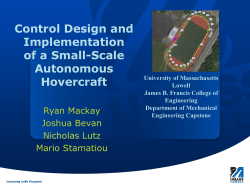
Hover Magic propeller Cambridge University Engineering Department
Cambridge University Engineering Department Hover Magic Using the kit provided make a hovercraft which travels 3m as fast as possible. KIT LIST ● battery box + batteries ● motor ● propeller ● polystyrene tray ● polystyrene cup ● cardboard ● large washer for weight adjustment (optional) propeller motor battery box air intake tray PLANNING Choose a base - large burger box or single polystyrene tray Choose an air intake – polystyrene cup or card template or both! CONSTRUCTION 1. Attach the propeller firmly to the motor. 2. Connect the battery box to the motor by pushing the wires through the holes in the motor terminals and twisting the wires to make a good electrical connection. The red wire should be connected to the negative (-) terminal. The black wire is connected to the positive (+) terminal. black wire ☺ Top Tip: The wires red wire must be connected this way for the propeller to motor push the air into the hovercraft. 3. Make the air intake. Either cut out a section of the cup or use the paper template to cut out and fold a cardboard air intake. ☺ Top Tip: Make sure that the propeller blades can turn freely when the motor and propeller are attached to the top. 4. Carefully cut out a matching hole in the polystyrene tray and stick the air intake to the hole. Please make sure that you are supervised as you cut the materials. Safety Note: • DO NOT place your fingers or face near the propeller blades or motor. • DO NOT use broken propeller blades. • Only switch on your hovercraft when the motor is securely attached to the polystyrene body. • This kit contains small parts which are not suitable for children under 3 years of age. www.eng.cam.ac.uk/outreach air intake polystyrene cup cardboard 5. Attach the motor, propeller and battery box. TEST! LIFT AND THRUST Air is blown into a chamber under the hovercraft. This trapped air lifts the hovercraft, so that it is literally floating on air. thrust air When it is floating, friction is greatly reduced, making it much easier to move. Air pushed to the rear provides the thrust to push the craft forward. tray lift air ☺ Top Tip: Take care so that the air doesn’t escape from the sides of your air intake. Use the tape to cover any gaps. PRESSURE FORCE AND AREA The upward force on the platform must be sufficient to lift the weight of the hovercraft. ☺ Top Tip: Try bases of different areas. What difference does the area make? upward air tray × = Force Pressure Area PROBLEMS TO THINK ABOUT The success of your hovercraft depends making the friction force between the hovercraft and the ground as small as possible. • How can you reduce the weight of the hovercraft? • Is the hovercraft balanced? Does air flow out evenly around all the edges? • Can you make your hovercraft travel in a straight line? ☺ Top Tip: Try moving the battery box to adjust the weight distribution. Sponsored by www.eng.cam.ac.uk/outreach
© Copyright 2025





















